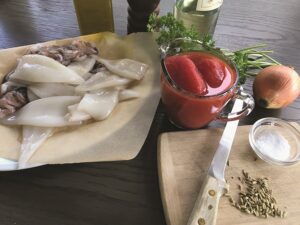They’re here!
After spending the winter offshore, squid arrive when the waters around Cape Cod begin to warm up. They come to spawn, with activity peaking from late April until around the first full moon in May. Their arrival bodes well for fishing — bluefish and striped bass love to eat squid — and for cooking.
In his legendary Provincetown Seafood Cookbook, Howard Mitcham calls squid “one of the world’s greatest seafood delicacies.” Besides being local, squid is also abundant. It’s protein-rich and, properly cooked, delectable — squid has a sweet, oceanic, yet slightly nutty flavor.
“But poor thing,” Mitcham wrote, “nobody knows how to cook him except a few million Chinese, Japanese, Siamese, Vietnamese … Portuguese, Italians, and Spaniards.”

If you haven’t done it before, cooking squid can seem intimidating. Crunchy, deep-fried calamari is many Americans’ first squid experience, most likely at a restaurant. But here on Cape Cod, there is an even simpler tradition: squid stew.
Portuguese squid stew was a mainstay at Cookie’s Tap in Provincetown, which served newly arrived Portuguese fishermen, and then artists and writers, for a good half-century. Mitcham’s version, said to come from Cookie’s, includes allspice, cumin, garlic, onion, tomato, potato, red wine, even Worcestershire sauce (in which anchovies are the secret supplier of umami), and enough cayenne “to make it hot as hell.”
The basic trick for squid at its tender best is to cook it quickly over high heat, on the grill for example, or slowly over low heat, as in a stew.
When I suggest it’s time for squid, Hugo will invariably have two ideas: first, that I cook it. Second, that we open the season with a stew of Italian origin that includes green peas, tomato, and a hint of fennel. I’ll agree, because one of our kitchen policies is that whoever expresses the most enthusiasm for preparing a dish is the right one to do it, and because this stew is ever so convenient to assemble after you’ve been organizing the garden all afternoon and want nothing more than a really good dinner without a fuss.
“Too bad it isn’t good for you,” Hugo will say, surveying the platter of squid surrounded by red and green vegetables. He often enjoys a second, even third serving, and with impunity.
Squidders are a secretive bunch. But one who lives in Brewster — he’ll only say his name is Conor — tipped me off to the squid’s arrival in Nantucket Sound over the weekend. “I’m going out next week,” he says. “I try to catch a year’s worth during the spring spawning run.”
He’s not going to share his squidding spots, but he will say “they’re infinitely more sustainable than everything else we take out of the water to eat, so I’m glad you’re writing about them.”
In season, you can find fresh squid at local seafood markets. When I called around last week, everyone said not yet but to check back in a few days.
Ideally, buy it cleaned. While some people think cleaning squid is fun, Denice Lapierre, who has long experience running her family’s Provincetown-based fishing operation on the F/V Isabel & Lilee, advised me that cleaning squid was something she had decided she was never going to do again.
Frozen squid is available most any time, and it’s sold cleaned. Almost unbelievably, that’s because much of the regional commercial catch, the majority of which is landed in Rhode Island, is frozen, shipped to Asia for processing, then refrozen and shipped back.

Which explains why freshly caught local squid is an event. (Fortunately, groups like Eating With the Ecosystem and the Rhode Island Food Policy Council are educating people about the importance of processing squid closer to home.)
This stew is classically Italian, with the lightest of seasonings giving the seafood center stage. A few fennel seeds enhance without overpowering. It takes under an hour to prepare, and any remaining can be transformed, by coarsely chopping it, into pasta sauce for another day.
Bread or rice complements the dish, and I like to serve a Sicilian orange salad afterward — sliced oranges with a splash of olive oil, a few olives, and chives, which are now well up in the garden.
Squid Stew With Green Peas and Fennel
4 servings
1 lb. cleaned squid
3 Tbsp. olive oil
½ onion, finely diced
2 garlic cloves, chopped
1 cup tomatoes, diced
½ cup water
½ cup dry white wine
2 Tbsp. parsley, chopped
1 tsp. fennel seed
Salt and pepper
½ cup peas
- Slice the squid tubes into rings about ½ inch wide and halve any large tentacles. Rinse the squid in cold water and dry on paper towels.
- Warm the olive oil in a large saucepan, add the onion and garlic, and cook until the onion turns light golden. Add the tomatoes, stirring and cooking for a few minutes before adding the water, wine, parsley, fennel seed, and salt and pepper to taste.
- Simmer for a few minutes and add the squid. Cover the pan and simmer slowly for about 30 minutes or until the squid is tender. Taste to check for doneness and seasoning.
- Add the peas and cook for another few minutes before serving.
Note: For pasta sauce, omit the peas and coarsely chop the cooked stew in a food processor.



